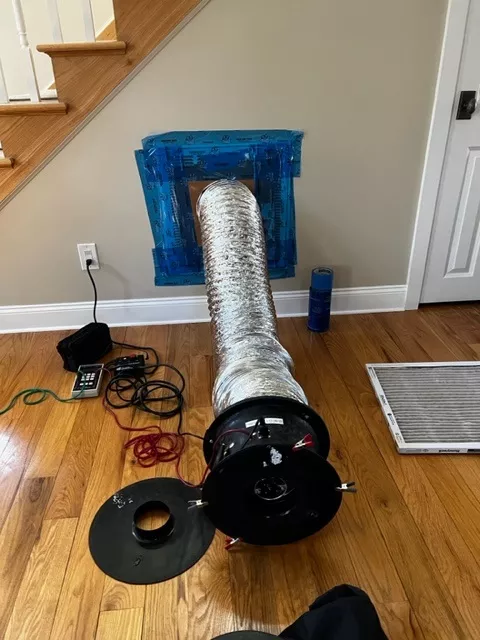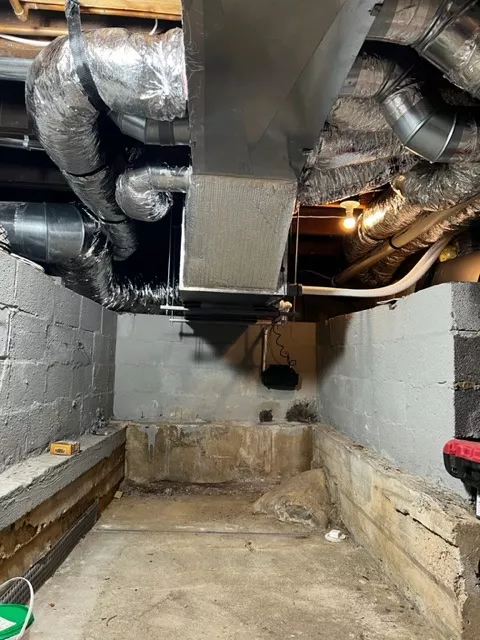How One Phius Staff Member Replaced Their Heating System
Phius Quality Assurance Manager Tony Lisanti recounts his experience replacing the heating system in his New Jersey home.
Phius Quality Assurance Manager Tony Lisanti recounts his experience replacing the heating system in his New Jersey home.
In our industry, doing the "right" thing is not always easy – or cheap.
But I hope that sharing real challenges in trying to lower energy use and make the switch to an all-electric household will hopefully make the task easier for those who follow.
As Phius professionals, we encourage, coach, cajole and generally arm twist designers, builders and trades people to consider building the Phius way. This of course includes electrification in an effort to curb carbon emissions at the site and source in the hope that our grid infrastructure will be cleaner in the next two decades.

For a typical homeowner with some basic knowledge, this means chasing leaks, adding insulation and changing expensive systems and appliances. Likely, most homes won't come close to meeting Phius standards, but the effort to reduce space conditioning and fossil fuel use helps. So what to do when immersed in the industry and your own heating system meets an untimely end?
This scenario is playing out in my home in northern New Jersey. The house in question is teardown/rebuild vintage 2002, and a "contractor special" to boot. There are telltale signs of the original owner doing it themselves. Not that the work is bad, but surely not up to today's Energy Code standards and nowhere near Phius level.
Having moved in late 2019, we haven't changed much other than appearance items. What we did do was grab the typical low hanging fruit – installing an insulated attic stair cover, sealing ductwork, air sealing attic bypasses, caulking windows and doors, doubling attic insulation where accessible, adding a “smart” hot water recirc pump that uses the cold water line as a return and installing WiFi enabled thermostats that can track usage and have customizable program schedules. The two gas furnaces and split A/C systems remain, along with sealed combustion water heaters. When the water heaters expire, a single ASHP unit will take their place.
The results of these modest energy improvements are as follows. Minimal air infiltration improvement from 6.5 ACH50 to 5.5 ACH50, HERS Index from slightly north of 100 down to 98. Borrowing an idea from the book ‘A House Needs to Breathe…Or Does It?’ – the calculated EUI is 19.3 – falling into the “inefficient” category for homes. Still, the cost for utilities was relatively low with a peak winter gas bill just over $200 and peak summer electric bill of $175.
Of my two gas furnaces, the highest efficiency (92 AFUE) suffered a cracked heat exchanger. I tried changing limit and roll out switches, hoping to limp along until spring, to no avail. It's kaput. And yes, I measure the CO levels at the supply outlets to ensure we're not slowly poisoning ourselves.
The easy button would be to replace the furnace with a new 95+ gas unit and upgrade the A/C coil and condenser to 14 SEER or better. Starting with a Manual J load calculation, the heating load was found to be just under 90 kBtu/hr and the cooling load 47 kBtu/hr. Yes, I will continue to nibble away at improvements to reduce the loads.

I explored all electric alternatives, namely cold climate air source heat pumps. Ground source was not a consideration as I have a septic field in the backyard and not much room to get a drilling rig in. With the help of one of my HVAC contractor colleagues, we matched up each floor's loads with heat pump combinations. Replacing just the one system would have been more cost effective, but as they say: go big or go home.
Ultimately, we decided to change both systems as with my luck the second gas unit would fail as soon as the contractor's van pulled away. So it would be two ducted units, and a third ductless unit for our basement to provide more zone control than I had with just two systems. All will be AHRI and NEEP Cold Climate Rated and the best overall efficiency available for one-to-one systems based on the loads (HSPF >11, SEER of 13 & 18 for the two ducted systems and 33 for the ductless unit).
This is not the easy way, nor was it inexpensive. The pay back in terms of gas vs. electricity costs is not quite equitable, and definitely not when considering the full install cost. Adding the heat pump systems results in the HERS Index dropping to 84 (threshold for DOE ZERH is typically 43 or lower). I’ll have to wait to calculate the EUI when I have post-install data. The projected energy cost savings of $43/yr for cooling but a cost increase of $313/yr for heating, netting a total increase of $270 per year. This is due to the higher electricity supply prices as compared to gas costs. Not exactly the best example of cost effective electrification.
This is far from the case in every building though, specifically in larger multifamily buildings where the economies of scale can be leveraged to significantly reduce costs.
So why do this? Because it is the right thing. In the long run, I will be ready for solar or a cleaner grid, will have a quiet, more efficient system, and increased comfort. And, I'm leveraging significant utility incentives (40%) that are available now rather than waiting for Inflation Reduction Act funds later in the year (I need heat now!). I'll take my chances with the electric rates.
These are not easy decisions, but in the end, it's one that I'm fortunate enough to live with.